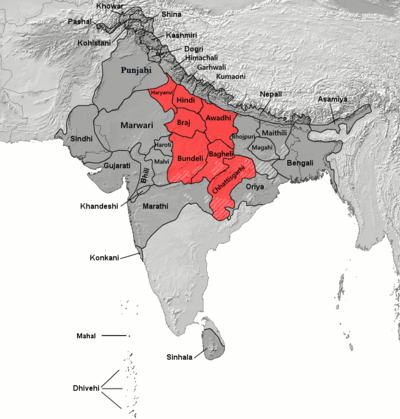
Search
Central Indo-Aryan languages

The Central Indo-Aryan languages or Hindi languages are a group of Indo-Aryan languages spoken across Northern and Central India. These language varieties form the central part of the Indo-Aryan language family, itself a part of the Indo-European language family. They historically form a dialect continuum that descends from the Middle Prakrits. Located in the Hindi Belt, the Central Zone includes the Dehlavi (Delhi) dialect (one of several called 'Khariboli') of the Hindustani language, the lingua franca of Northern India that is the basis of the Modern Standard Hindi and Modern Standard Urdu literary standards. In regards to the Indo-Aryan language family, the coherence of this language group depends on the classification being used; here only Eastern and Western Hindi languages will be considered.
Languages
If there can be considered a consensus within the dialectology of Hindi proper, it is that it can be split into two sets of dialects: Western and Eastern Hindi. Western Hindi evolved from the Apabhraṃśa form of Shauraseni Prakrit, Eastern Hindi from Ardhamagadhi Prakrit.
This analysis excludes varieties sometimes claimed for Hindi for mere political reasons, such as Bihari, Rajasthani, and Pahari. But they are languages much older than Hindi.
Seb Seliyer (or at least its ancestor) appear to be Central Zone languages that migrated to the Middle East and Europe ca. 500–1000 CE. Parya is a Central Zone language of Central Asia.
To Western Hindi Ethnologue adds Sansi, Bagheli, Chamari (a spurious language), Bhaya, Gowari (not a separate language), and Ghera.
Use in non-Hindi regions
- Bihari Hindi is a dialect of Hindustani greatly influenced by Bihari languages such as Bhojpuri and Magahi, spoken in urban areas in Bihar.
- Bombay Hindi ("Bombay Baat"), the dialect of the city of Mumbai (Bombay); it is based on Hindustani but heavily influenced by Marathi. Technically it is a pidgin, i.e. neither is it a native language of any people nor is it used in formal settings by the educated and upper social strata. However, it is often used in the films of Hindi cinema (Bollywood) because Mumbai is the base of the Bollywood film industry.
- Dakhini, including Hyderabadi Urdu, and Bangalori Urdu, a dialect of Urdu spoken in the present areas of the erstwhile Hyderabad State, and the historical Deccan region. There is a small but distinct difference between Dakhini and standard Hindustani, which is bigger the further south it is spoken.
- Andaman Creole Hindi is a trade language of the Andaman and Nicobar Islands.
- Arunachali Hindi is a trade language of Arunachal Pradesh
- Haflong Hindi is a trade language of the areas adjacent to Haflong in Assam
- Fiji Hindi is an Eastern Hindi-Bihari lingua-franca that developed among Indo-Fijians.
- Caribbean Hindustani is an Bihari-Eastern Hindi lingua-franca that developed among Indo-Caribbeans.
- Domari and Romani are both central Indo-Aryan languages, although deriving from separate origins within the family.
Comparison
The Delhi Hindustani pronunciations [ɛː, ɔː] commonly have diphthongal realizations, ranging from [əɪ] to [ɑɪ] and from [əu] to [ɑu], respectively, in Eastern Hindi varieties and many non-standard Western Hindi varieties.
Notes
References
Bibliography
- Shapiro, Michael C. (2003), "Hindi", in Cardona, George; Jain, Dhanesh (eds.), The Indo-Aryan Languages, Routledge, pp. 276–314, ISBN 978-0-415-77294-5
Text submitted to CC-BY-SA license. Source: Central Indo-Aryan languages by Wikipedia (Historical)
Articles connexes
- Indo-Aryan languages
- Proto-Indo-Aryan language
- Eastern Indo-Aryan languages
- Middle Indo-Aryan languages
- Indo-Aryan peoples
- Western Hindi languages
- Bundeli language
- Indo-Aryan migrations
- Indo-Iranian languages
- Northern Indo-Aryan languages
- Parya language
- Eastern Hindi languages
- Dardic languages
- Aryan
- List of ancient Indo-Aryan peoples and tribes
- Bagheli language
- Indo-Iranians
- Bhojpuri language
- Aryan race
- Graeco-Aryan
Owlapps.net - since 2012 - Les chouettes applications du hibou



